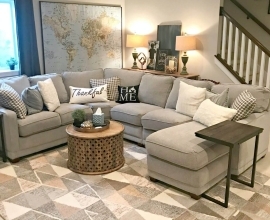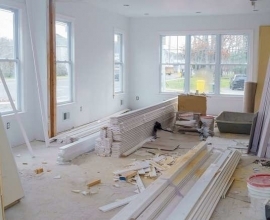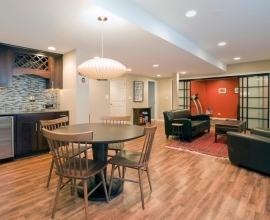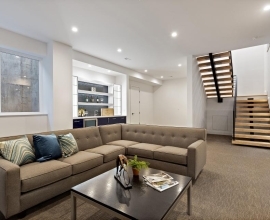Government’s HomeBuilder handout doesn’t come cheap
Multiple rooms in the average Australian home would have to be significantly renovated to access the government’s $25,000 HomeBuilder grant, a program aimed at keeping the construction industry afloat as Australia heads into its first recession in almost three decades.
Last month, the Morrison government announced it would hand out $25,000 grants for eligible homeowners to substantially renovate their homes or build new ones.
But the money isn’t free. Recipients would need to spend $150,000 of their own money on renovations, or build a new home to live in costing less than $750,000.
The stimulus package was met with praise from Denita Wawn, CEO of Master Builders Australia, who says it will be “a lifeline for an industry facing a valley of death in the coming months”.
But opposition leader Anthony Albanese criticised the $150,000 entry point at a time of great economic uncertainty.
The sustainability sector also called out the government for missing an opportunity to shift the building industry to a more sustainable future, raising questions on energy and thermal performance of new builds.
Geoff Woda, the owner of Essendon Home Improvements, a longstanding Melbourne construction company says, “in terms of doing a $150,000 renovation, you would need to do much more than just the bathroom.”
“Most bathroom renovations with middle of the range fittings would probably work out to be around $25,000, as a real rough figure depending on what is being done … that figure can quickly creep up.
“But if someone was to renovate a whole house, doing something like a kitchen renovation, a bathroom and an ensuite, maybe replacing a couple of windows in an old house, and if it’s a weatherboard house, doing a whole lot there, they could reach the mark.”
Woda says homeowners would have to commit to multiple home improvements to clock up $150,000, but points out it would be “relatively easy” to reach that figure with an extension.
“Before the COVID-19 crisis, more than 50 per cent of our contracts hit the $150,000 mark, because once you get into extensions they usually become more detailed and more expensive,” he said.
“$150,000 would be a relatively small extension, like a rectangular family room out the back on top of an existing one.”
Large scale renovations are not uncommon, Woda says, only recently did he do a job where the client “did up their bathroom and kitchen and changed some doorways in their house, they had a couple of wall changes and sections added in to create another bedroom, some window repair works and lots of small miscellaneous things including a little bit of spouting repairs on the house”.
While that particular job listed multiple refurbishments, Woda says “it wasn’t $150,000, it was way less”.
For many, including himself, work “came to a grinding halt” because of the COVID-19 pandemic, Woda says. The fear of the unknown sent people scrambling to pull out of contracts, putting hundreds upon thousands of people working in the construction industry out of a job.
However, he has already had three enquiries specifically associated with the grant, a welcome spark of activity following a bleak start to the year.
“Most builders and tradesman had been hit fairly hard by COVID-19 in the early months and I had a lot of people pull of jobs that I had even signed up legal contracts with. But if someone doesn’t want you in their house because they are worried about losing money on their investment, or worried about losing their own job, or worried about tradesmen coming to the house and potentially spreading Covid, then that is understandable.”
While the Morrison government is hoping the incentive will provide a boost to the construction industry and help support 140,000 direct jobs, social activists say it has missed the mark.
RMIT senior lecturer in construction and member of the Sustainable Building Innovation Laboratory Trivess Moore said the $688 million HomeBuilder scheme had the potential to deliver much-needed sustainability benefits to a multitude of homes, ensuring they are cheaper to run.
“Quite often people think sustainable features will add additional costs, so it is one of the first things that falls out of a house budget. Although, through good design those costs can often be reduced to nothing,” he said.
He said he would have liked the scheme to require delivering sustainable projects above the minimum building code requirements.
“So for new housing that might have been a seven star performance requirement outcome, for which there is research showing for many climate zones in Australia that shouldn’t cost any additional money compared to a six star if you do the design right.
“I don’t think that adding sustainability requirements would have seen any less new houses being built or any less renovations being undertaken.”
While he points to a shift in consumer awareness on the impacts of sustainable choices, he says there is still a lack of awareness among the general public about the cost benefits of alternative options such as improving insulation levels, adding double glazing and making sure all the gaps and cracks in a home are sealed.
“The home builder package was a missed opportunity to really start to help shift outcomes in the building industry towards a more sustainable future,” he said.
“There have been very few times in the history of governments in Australia where environmental performance of housing has had the attention it should.”
Likely, the government was reluctant to be seen adding any form of red tape to the building industry, he said, when there is already a precedence of the government preferring the market to decide if it wants sustainable options.
“Given the current financial crisis I suspect it may have been a bridge too far to include something that is perceived to add additional costs,” he said.
“But it is not just about the performance of these particular dwellings, it is about starting to reshape the industry as we start to transition to a more sustainable future. It is about really starting to think strategically about the type of industry we want in Australia, and start to think about whether we have the ability to produce and manufacture sustainable products and materials locally.”
Mary Ann Jackson, a built environment accessibility specialist and director of Visionary Design Development in Victoria, says the same, minimal, amount of attention has been paid to social housing, adding renovations to existing housing is “urgently needed”.
“The cost of alterations of any sort are often well beyond the budget of those that need them most: people on the aged pension, people with disability and people in precarious living situations,” she said.
“Providing $25,000 of government assistance toward home modification for older people and people with disability ineligible for NDIS support would make an immeasurable difference to the quality of life for many, many Australians not just the lucky few homeowners who are already in a position to spend $150,000 on substantial renovations.”
When the PM first announced the scheme, the Grattan Institute’s household finances program director Brendan Coates immediately labelled it “bad economics”, saying it would be better put to use updating and building new social housing.
He sees the grant encouraging builders and tradesmen to drive up prices, and the race to build a new home worth less than $750,000 will only elevate figures.
“Building 30,000 new social housing units today would cost between $10 billion and $15 billion, it would support the building industry, and [just] as important, would help many of the 116,000 Australians who are homeless on any given night,” he said.
Source: https://bit.ly/2ZassoU







